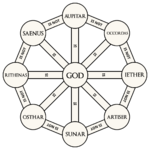Igniscism

|
This article is a Stub
Please help out the Industria Pacificum Wiki by adding to it.
|
Igniscism is a monotheistic religion descended from Amulndian Polytheism articulated by The Book Of Teachings written by the prophet Dunister Ignisc. Igniscism is the world's second largest religion, with over three hundred and ninety million adherents across the world, encompassing 23.7% of the global population. Its holy city is Kiros, the religious and state capital of the nation of Xhequa.
Beliefs[edit | edit source]
God[edit | edit source]
The God of Igniscism is a singular, omnipotent, omniscient, omnipresent entity that assumes eight forms to enact its will, known collectively as the Octarchy. These forms are descended from the pantheon of Amulndian Polytheism, where they were originally worshipped as separate gods.
- Aupitar. Aspect of fate and divine right. A fusional deity descended from the Amulndian Great Mover and Sky-father deities. Popularly depicted as the Father Lion, and is treated as the premier form of God.
- Occordas. Aspect of law and order. Descended from the Constructive Agent.
- Iether. Aspect of birth, parenting and the family. Descended from the Sky Mother.
- Artiser. Aspect of art, construction and manual labour. Descended from the Builder God.
- Sunar. Aspect of goodness, piety and sunlight. Descended from the Sun Goddess.
- Osthar. Aspect of truth and justice. Descended from the Truth God.
- Rithenas. Apsect of victory and perseverance. Descended from the Victory God.
- Saenus. Aspect of peace, stability, water and the seas. Descended from the Sea Goddess.
Afterlife[edit | edit source]
Festivals[edit | edit source]
Morality[edit | edit source]
All about manifest destiny, man conquering nature, achieving the will to power.


